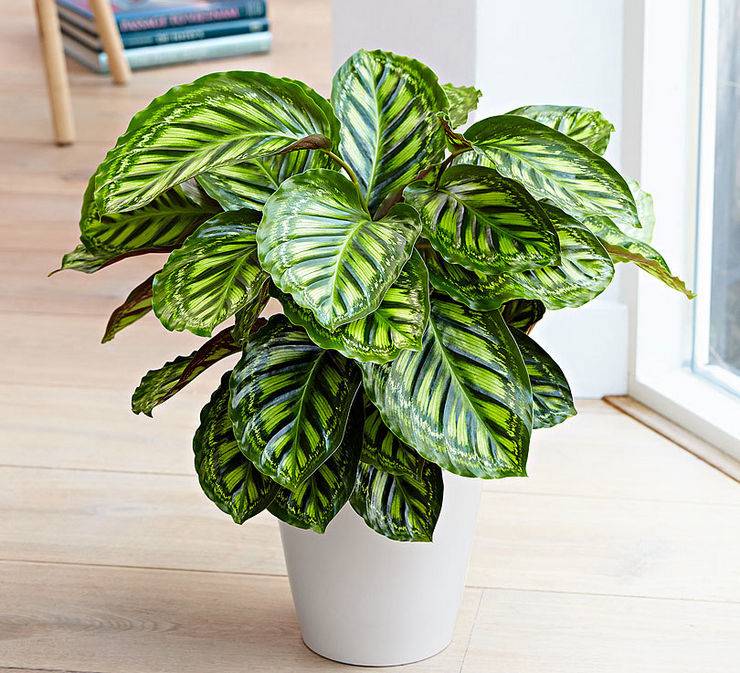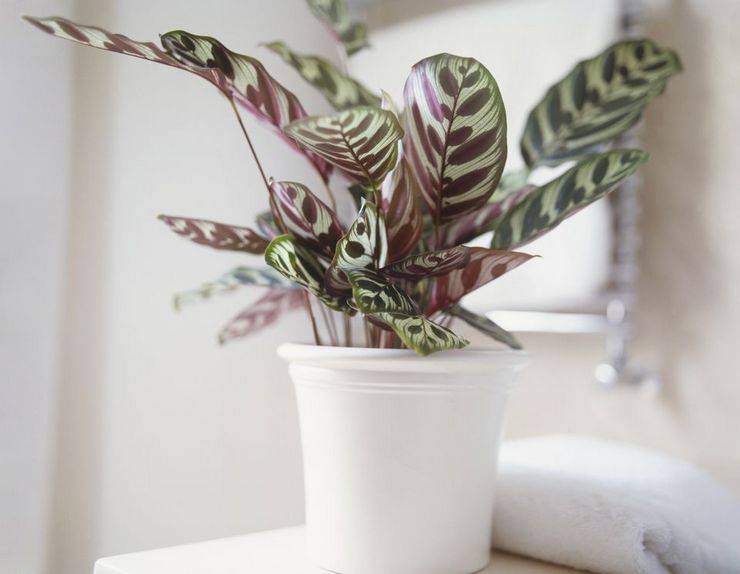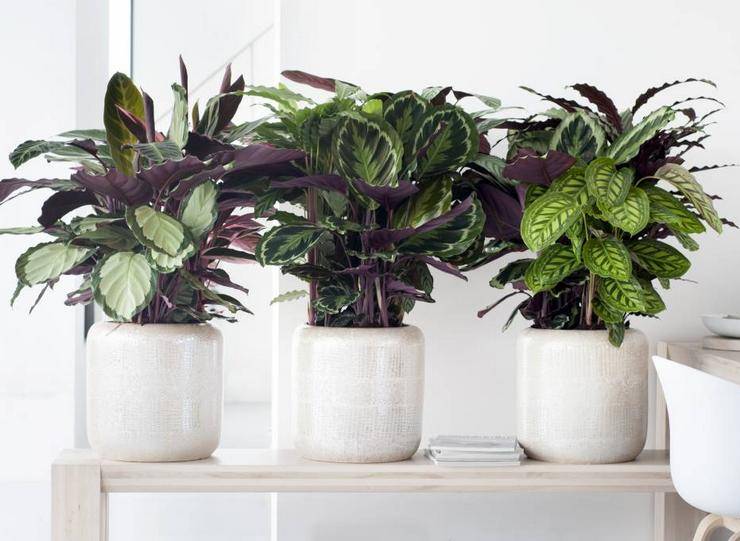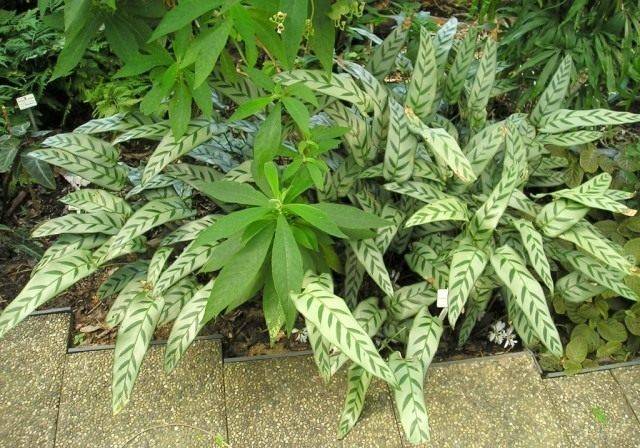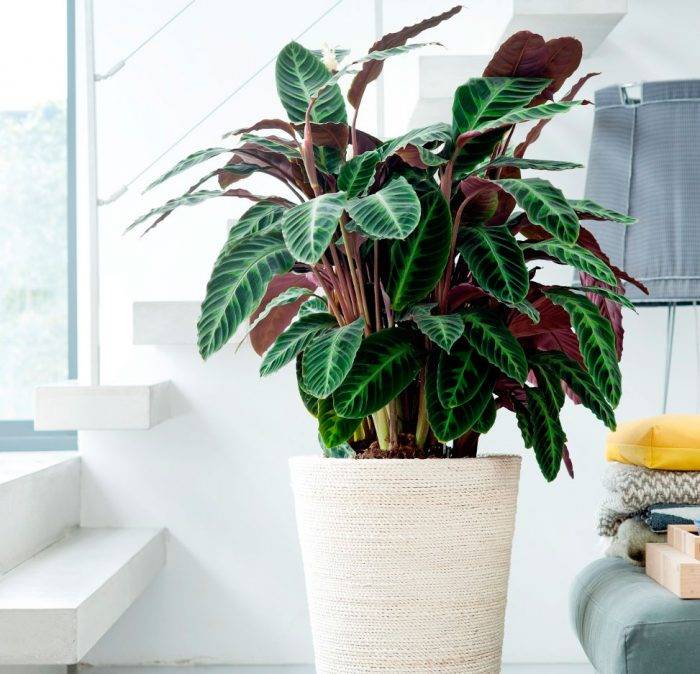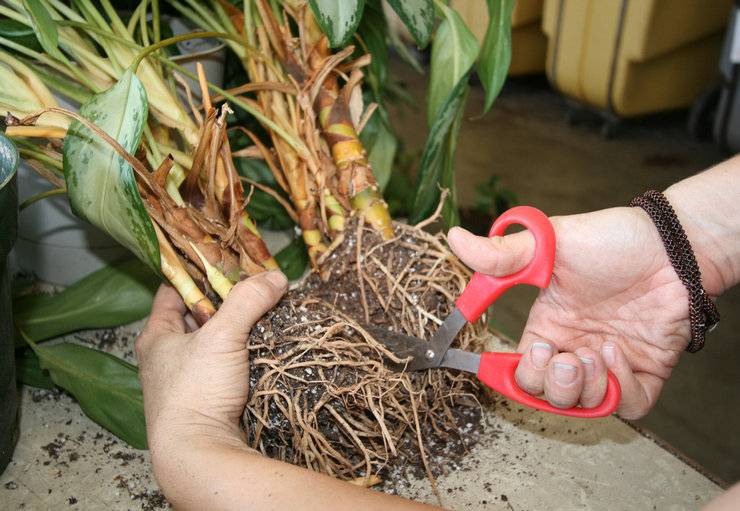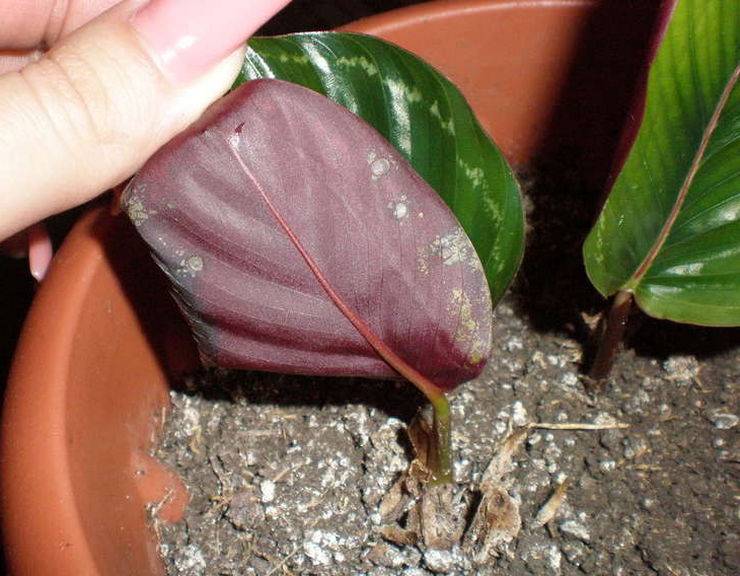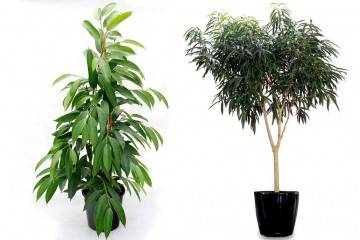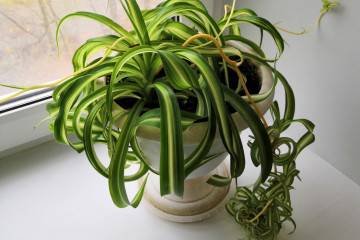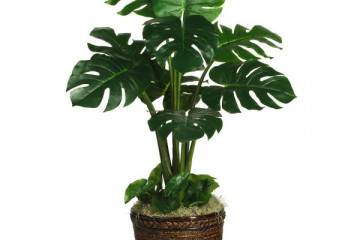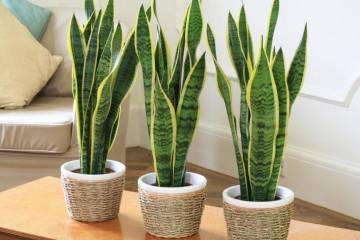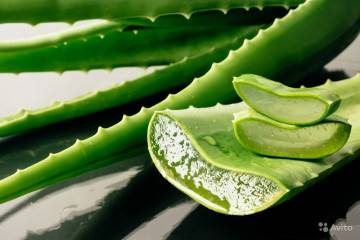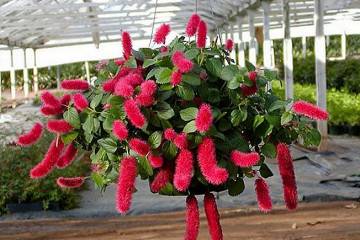Calathea flower - home care
Content:
The variety of calathea species, striking with the variegation of their decorative foliage, makes the choice when buying a plant difficult. In any flower shop, the plant is unlikely to go unnoticed. However, connoisseurs of home plants, when buying this tropical beauty, should remember that calathea is a wayward and capricious flower. You will have to take care of him carefully, but in return he will thank you with lush greenery of variegated leaves, and possibly with flowering.
Description of calathea
The homeland of the motley calathea, belonging to the Marantovaya family, is the tropics. In natural habitat, the plant prefers the banks of rivers and lakes rich in moisture.
Calathea is a perennial that can store moisture during heavy tropical rains, so its roots are in the form of either a tuber or rhizomes. At home, the plant grows up to 1 m, rarely a little higher.
The leaf plates are large, oval or lanceolate; they can be either even or wavy along the edge. The petioles of the leaves are rather long, and the internodes are somewhat shortened. The color of the underside of dense and lush foliage can be dark green or with a purple tint. The upper side of the leaves is variegatedly colored.
The division of white veins into certain segments is clearly visible, as well as the central vein, which at one time the natives used to weave baskets. Hence, by the way, and the name of the plant (translated means "basket"). Each year, the growth is about 5-6 leaves.
Calathea: home care
The principles that need to be followed when caring for a home version of Calathea are based on the fact that this plant is native to the tropics. This is due to his love for high humidity and frequent watering.
Temperature
The plant during the active growing season is kept at a normal room temperature from 20 ° C to 24 ° C. In winter, if a dormant period is provided for kalatee, it must be kept at a temperature of 15-16 ° C.
Lighting
Bright lighting adversely affects the variegated coloring of the leaves, they lose their brightness and can curl with excess lighting. Direct sunlight can even cause burns.
But placement in too dark corners of the room will also not do the flower good. With a clear lack of lighting, foliage can lose its attractiveness, moreover, it slows down in growth and becomes small. Therefore, the best option for placing calathea will be partial shade.
Watering
A tropical plant has its own requirements for water: it must be soft and always warm.It is best if it is melt water or rainwater. When watering, be sure to remember that moisture stagnation can cause rotting of the root system, therefore, after the procedure, it is better to drain the water from the pan.
The frequency of watering in summer directly depends on temperature indicators and ranges from 2 to 3 times a week, in winter this usually happens no more than once every seven days. The indication for watering is a dried topsoil.
Spraying
Spraying is permissible for smooth-leaved species of calathea, while the sprayer should be with a very fine mesh. It is impossible to irrigate plant species with pubescent and velvety foliage. They are shown only bathing once every 2 weeks under a warm shower. You can only irrigate the air around the flowerpot with the plant.
The accumulated dust on the leaves is carefully removed either with a brush or with a dry napkin. But with any manipulation of the plant, care should be taken, since the surface of the foliage is very delicate and easily injured.
Humidity
To maintain the moisture threshold necessary for the normal life of the plant, it is recommended to place the flowerpot on moistened pebbles or moss. At the same time, it is impossible to allow the presence of an obvious liquid in the pallet; you should only keep the pebbles or moss wet.
Priming
Calathea will need light, well-drained soil. If the substrate is prepared independently, then it must necessarily include peat, sand and leafy soil. It is also advisable to add chopped charcoal, pieces of bark, coniferous soil and humus.
Top dressing
When fertilizing and caring for calathea, it should be remembered that it is very easy to overfeed the plant, but it is difficult to achieve lush vegetation without an adequate supply of minerals. Therefore, in the summer, the plant is fed every 2 weeks with liquid fertilizers for ornamental crops that do not contain nitrogen and potassium. Flowering species will need special fertilizer for flowering plants.
Features of care in winter during a dormant period
The rest period is not pronounced. Just in winter, so that the plant, especially the flowering one, rests, reduce the frequency of watering and the air temperature.
Flowering features
Calathea, or rather its species that bloom, may require additional lighting if the flowering period falls on the winter months, when there is not enough natural light. This is required, for example, by saffron calathea, which stands out among other varieties with bright yellow and orange inflorescences.
The flowering of some varieties of calathea is also accompanied by a specific smell, which some growers find unpleasant.
Common types of calathea
Among the varietal variety of kalatei, flower growers note the following types:
- Calathea Makoya. A feature of the species are large leaves with a bizarre pattern in the form of small leaves, and the pattern is repeated on the underside of the plate, but in a burgundy color. The flower looks especially colorful in the evening, when the leaves begin to roll up;
- calathea Varshevich. This species is distinguished by colorful flowers in the form of spikelets, which bloom towards the end of spring. The leaves are velvety dark green with a herringbone pattern, the underside is burgundy;
- Calathea Crocata (saffron) - one of the most colorful species, which is distinguished by a lush bright orange flowering;
- calathea Medallion.On the oval dark green leaves, there are silvery and purple spots, and the underside is painted in bright purple;
- lanceolate calathea is characterized by long leaves with a prominent central vein and wavy edges;
- striped calathea. Large leaves of bright green color are covered with symmetrical stripes. The variety dissolves white and purple inflorescences;
- Calathea Rufibarba grows in the form of a spreading bush, formed by narrow leaves on top of a bright green, and below a lilac-pink color;
- Calathea Bahema. Leaves are leathery lanceolate with a silvery-green pattern;
- Calathea Orbifolia (round-leaved) has round shiny green leaves with brown stripes;
- Calathea Lubbers is tall. Its leaves are large with asymmetrical yellow spots;
- Calathea Lancifolia. The leaves are wavy, elongated with a specific interesting pattern;
- Calathea Sanderian. Large oval leaves with white or beige stripes;
- calathea mix. This species resembles a striped one, but here there are light lines on a dark background;
- Calathea Misto. Leaves are not very large, silver-olive color with small splashes;
- calathea Network (mosaic) is not similar to other species, the color of its large leathery leaves resembles a laid out mosaic;
- calathea Leopardina (leopard). Lanceolate leaves with light green and dark green stripes. The variety dissolves spike-shaped yellow inflorescences;
- Calathea Dotti is a very unusual variety with large leaves, on which the outlines of another leaf are painted in purple.
Breeding methods for calathea
This tropical plant can be propagated by germinating seeds, rooting cuttings, dividing the bush and using air layers.
- Germination of seeds. This is one of the most difficult methods, as the probability that the seeds will not sprout is too high. Sprouted seedlings dive into separate containers and grow there to an adult state.
- Rooting cuttings. A stalk is cut from the parent plant and rooted in a wet substrate, covered with a plastic bottle or jar. Cuttings often do not take root.
- Division. The easiest way of reproduction is when, during transplantation, the old, overgrown bush is carefully divided into parts.
Plant transplant
It is advisable to replant the flower annually. This is done at the beginning of the growing season by carefully transferring the plant along with the soil, otherwise the delicate roots can be damaged.
The pot is chosen not too deep, but wider than the old one. On the sides of the centrally located flower, fresh substrate is simply poured. It is not worthwhile to strongly compact the soil.
Possible growing problems and diseases of calathea
Most often, the plant is affected by fungal diseases and spider mites. This is facilitated by improper care and maintenance at low temperatures and with stagnant moisture. To combat them, they are treated with fungicides and insecticides. Moreover, in the case of treatment of a plant affected by fungi, it must be urgently transplanted, otherwise it may die.
Among the most common problems in growing, growers name the following:
- leaves dry, starting from the edge, and curl - lack of moisture and watering;
- leaves become faded - in low light;
- leaves turn yellow - at low temperatures and drafts;
- spots appear on the leaves - sunburns.
The answer to the question of why problems arise is simple - the care of a demanding plant is carried out incorrectly, so it needs to be adjusted.
Signs and superstitions
This tropical beauty is endowed with unusual abilities, therefore, it has a beneficial effect on family well-being and happiness, and also absorbs negative energy. In a house where there is a calathea, peace, carelessness and love reign.
Calathea is a colorful plant with variegated decorative foliage of a wide variety of colors and patterns. Since in nature the plant lives in the tropics, it needs high humidity and frequent watering. Caring for calathea cannot be called very simple, but the colorful foliage and flowers of some species are more than worth the investment.
